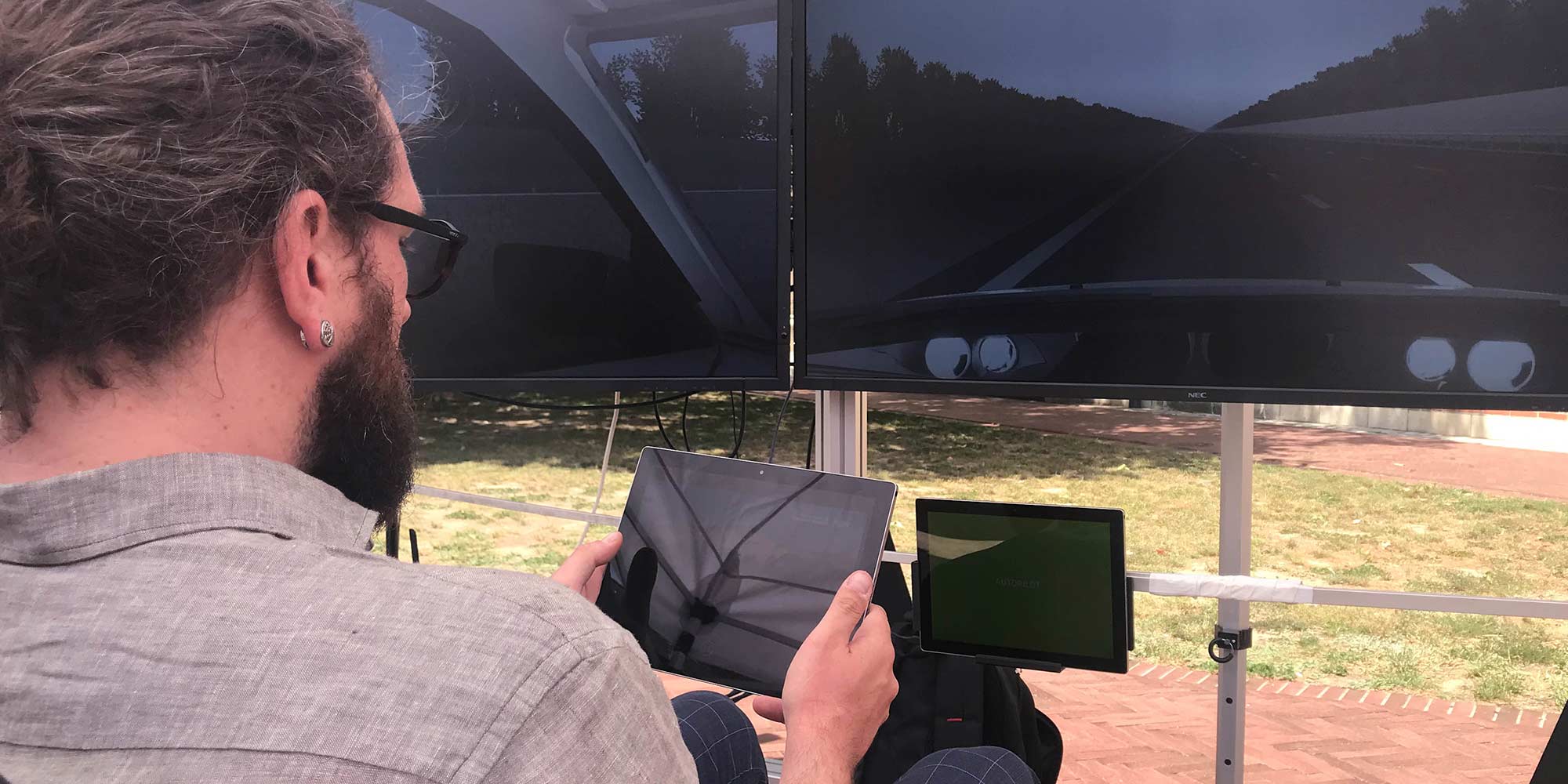Automated vehicles promise to increase safety, but pose a new challenge for vulnerable road users like pedestrians or cyclists. How can we integrate unprotected humans in traffic systems that are controlled by intelligent transportation systems, and how can someone communicate with automated vehicles when there are no human drivers?

and Measurement Area, Technische Hochschule Ingolstadt (DE), Credits: CARISSMA, Technische Hochschule Ingolstadt
This installation from CARISSMA/THI combines a driving and a bicycle simulator and allows visitors to become part of futuristic smart traffic systems, while participating in a real scientific experiment. Emerging study results are analyzed in real time and presented on large screens with the aim of making safety research comprehensible and accessible throughout the exhibition.
Project Credits:
- CARISSMA — Center of Automotive Research on Integrated Safety Systems and Measurement Area
- Technische Hochschule Ingolstadt (THI)
- Philipp Wintersberger (AT), Anna-Katharina Frison (DE), Tamara von Sawitzky (DE), Andreas Locken (DE), Stavros Tasoudis (GR), Martin Nothhelfer (DE), Andreas Riener (AT)
- SAFIR — Safety for all — Innovative Research Partnership on Global Vehicle and Road Safety Systems
- MenschInBewegung
- SAVe — Funktions- und Verkehrssicherheit im automatisierten und vernetzten Fahren
Biographies:
Philipp Wintersberger (AT) is a researcher at the research center CARISSMA/THI and obtained his diploma in Computer Science from Johannes Kepler University Linz, specializing in human-computer interaction and computer vision. He worked 10 years as a software engineer/architect and has been invited to speak about mobile computing and software development at several conferences/events. In January 2016, he joined the Human-Computer Interaction Group at CARISSMA/THI to conduct research in the area of human factors and driving ergonomics, focusing on trust in automation, intelligent/attentive user interfaces for automated vehicles, and augmented/virtual reality.
Anna Katharina Frison (DE) is a UX researcher at Technische Hochschule Ingolstadt (THI) and doctoral candidate at Johannes Kepler University (JKU) Linz in Austria since 2016. She received her master’s degree at the Chair for Human-Machine Interaction at LMU Munich. After working at the design agency designaffairs as a usability engineer in several IoT projects, e.g., for BOSCH and Nestlé, she is now researching how to design delightful and satisfying experiences for automated driving systems. She considers the topic from a user-centered design perspective by analyzing existing approaches (UX methods) with special regard to individual needs and the challenges of industry and academia.
Tamara von Sawitzky (DE) is a research associate at Technische Hochschule Ingolstadt (THI) and a PhD candidate at Johannes Kepler University Linz (JKU).
She received her bachelor’s degree in mechatronics and her master’s degree in applied research (focus on computer science) at THI. Her research focuses on ways to increase cyclist safety by using augmented reality technology. Within the project “Mensch in Bewegung,” she investigates potential on-bike safety features in (partly) virtual simulations and outdoor tests.
Andreas Löcken (DE) joined the Technische Hochschule Ingolstadt (THI) in Germany as an HCI researcher in 2018. He received his M.Sc. degree in computer science from the University of Oldenburg, Germany, where he also defended his dissertation on the topic of designing and evaluating in-vehicle ambient light displays to support drivers in 2019. His current research focus lies on the interaction between humans and automated vehicles. Specifically, he focuses on vulnerable road users, such as pedestrians or cyclists, and the passengers of self-driving cars, and develops new interaction concepts evaluated in virtual reality.
Stavros Tasoudis (GR) is an HCI researcher at Technische Hochschule Ingolstadt (THI) since 2019. He has recently submitted his dissertation in human-computer interaction. During the last few years, he researched and designed for user experiences, and cooperated with industrial partners such as Jaguar Land Rover. He explored the automotive domain limitations and designed a remote interactive system to support participatory UX activities in automated vehicles. In his research, he focuses on the analysis of rich qualitative data on what participants say and do, reporting their explicit, observable, tacit, and latent needs.
Martin Nothhelfer (DE) is a designer and creative director currently living and working in Munich. As the creative soul and founder of pretty bloody simple he is melting stardust to create magic moments with interactive installations. Martin lived in New York and worked for agencies such as Pentagram, Red Paper Heart and Sagmeister & Walsh. He has created award winning work and has more than 12 years of professional experience in the creative industry. He loves to experiment at the intersection of design, art and technology. Martin studied communication design at the University of Applied Sciences in Augsburg and Moholy-Nagy University of Art and Design in Budapest.
Andreas Riener (AT) is a professor for human-machine interaction and virtual reality at Technische Hochschule Ingolstadt. He also has a co-appointment at CARISSMA (Center of Automotive Research on Integrated Safety Systems and Measurement Area) as research professor for human factors and driving ergonomics. He received his PhD in computer science in 2009 (University of Linz, Austria) and was awarded the venia docendi in applied computer science in 2014. Andreas’ research interests include virtual testing of automated driving concepts (using mixed-reality approaches), driver behavior and safety, human factors in driver-vehicle interfaces, driving ergonomics, vital state estimation from psycho-physiological measures, as well as topics related to (over)trust, acceptance, and ethical issues in automated driving. He has worked on a number of EU, national, and industrial research projects and is an active reviewer for IEEE, ACM, Springer journals and conferences in the broader field of HCI and human factors.


